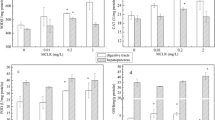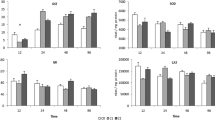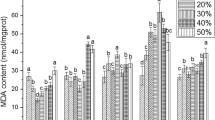Abstract
Lead (Pb) is a common pollutant in aquatic ecosystems, which produces a wide range of toxic biochemical effects in different organisms. The aim of the present study was to explore the mechanisms of acute toxicity and antioxidant defenses in freshwater crab Sinopotamon henanense induced by Pb. Hepatopancreas was collected from S. henanense exposed for 96 h to Pb (0, 9.188, 18.375, 36.75, 73.5, and 147 mg/l). Oxidative stress was examined using a suite of assays in crabs, including contents of hydrogen peroxide (H2O2) and malondialdehyde (MDA), activities of antioxidative enzymes such as superoxide dismutase (SOD), catalase (CAT), and glutathione peroxidase (GPx), and glutathione system-related parameters such as glutathione (GSH), glutathione S-transferase (GST), and glutathione reductase (GR). A dose-dependent increase of H2O2 and MDA was observed in the crabs after Pb exposure, while antioxidative enzymes activities were suppressed significantly (P < 0.05) at higher concentrations of Pb. The ratios of CAT/SOD, GPx/SOD, and GR/GPx were also suppressed. Our results suggested that acute exposure of Pb causes lipid peroxidation and harmful lessened antioxidant defenses of crabs. The above parameters were evaluated as potential biomarkers for Pb pollution monitoring and health assessment of crabs which is also important for the aquaculture of crabs.




Similar content being viewed by others
References
Aebi, H., 1984. Catalase in vitro. Methods in Enzymology 105: 121–126.
Almeida, J. A., Y. S. Diniz, S. F. G. Marques, L. A. Faine, B. O. Ribas, R. C. Burneiko & E. L. B. Novelli, 2002. The use of the oxidative stress responses as biomarkers in Nile tilapia (Oreochromis niloticus) exposed to in vivo Cd contamination. Environment International 27: 673–679.
Alscher, R. G., N. Erturk & L. S. Heath, 2002. Role of superoxide dismutases (SODs) in controlling oxidative stress in plants. Journal of Experimental Botany 53: 1331–1341.
Amicarelli, F., A. M. Ragnelli, P. Aimola, A. Bonfigli, S. Colafarina, C. Di. Ilio & M. Miranda, 1999. Age-dependent ultrastructural alterations and biochemical response of rat skeletal muscle after hypoxic or hyperoxic treatments. Biochimca Biophysica Acta 1453: 105–114.
Ana, Z., G. Susana & M. S. Luisa, 2007. Oxidative stress is not related to the mode of action of herbicides that inhibit acetolactate synthase. Environmental and Experimental Botany 59: 150–159.
Avanzo, J. L., J. Mendonca, C. X. Pugine & M. C. Cesar, 2001. Effect of vitamin E and selenium on resistance to oxidative stress in chicken superficial Pectoralis Muscle. Comparative Biochemistry and Physiology 129: 163–173.
Bradford, M. M., 1976. A rapid and sensitive method for the quantification of microgram quantities of protein utilizing the principle of protein-dye binding. Analytical Biochemistry 72: 248–254.
Cajaraville, M. P., M. J. Bebiannob, J. Blascoc, C. Ported, C. Sarasquetec & A. Viarengo, 2000. The use of biomarkers to assess the impact of pollution in coastal environments of the Iberian Peninsula: a practical approach. Science of the Total Environment 247: 295–311.
Chelomin, V. P., M. V. Zakhartsev, A. V. Kurilenko & N. N. Belcheva, 2005. An in vitro study of the effect of reactive oxygen species on subcellular distribution of deposited cadmium in digestive gland of mussel Crenomytilus grayanus. Aquatic Toxicology 73: 181–189.
Dafre, A. L., I. D. Medeiros, I. C. Müller, E. C. Ventura & A. C. D. Bainy, 2004. Antioxidant enzymes and thiol/disulfide status in the digestive gland of the brown mussel Perna perna exposed to lead and paraquat. Chemico-Biological Interactions 149: 97–105.
Elbekai, R. H. & A. O. S. El-Kadi, 2005. The role of oxidative stress in the modulation of aryl hydrocarbon receptor–regulated genes by As3+, Cd2+, and Cr6+. Free Radical Biology & Medicine 39: 499–1511.
El-Shenawy, N. S., A. Mohammadden & Z. H. Al-Fahmie, 2012. Using the enzymatic and non-enzymatic antioxidant defense system of the land snail Eobania vermiculata as biomarkers of terrestrial heavy metal pollution. Ecotoxicology and Environmental Safety 84: 347–354.
Fatima, R. A. & M. Ahmad, 2004. Certain antioxidant enzymes of Allium cepa as biomarkers for the detection of toxic heavy metals in wastewater. Science of the Total Environment 346: 256–273.
Frenzilli, G., M. Nigro, V. Scarcelli, S. Gorbi & F. Regoli, 2001. DNA integrity and total oxyradical scavenging capacity in the Mediterranean mussel, Mytilus galloprovincialis: a field study in a highly eutrophicated coastal lagoon. Aquatic Toxicology 53: 19–32.
Fu, J. H., W. B. Zhang, K. S. Mai, X. N. Feng, W. Xu & Z. G. Liufu, 2006. Effect of dietary vitamin D on growth and antioxidant responses of abalone Haliotis discus hannai Ino. High Technology Letters 16: 1306–1311.
Habig, W. H., M. J. Pabst & W. B. Jakoby, 1974. Glutathione S-transferases. The first enzymatic step in mercapturic acid formation. The Journal of biological chemistry 249: 7130–7139.
Ivanina, A. V., A. S. Cherkasov & I. M. Sokolova, 2008. Effects of cadmium on cellular protein and glutathione synthesis and expression of stress proteins in eastern oysters, Crassostrea virginica Gmelin. The Journal of Experimental Biology 211: 577–586.
Johnson, F. M., 1998. The genetic effects of environmental lead. Mutation Research 410: 123–140.
Luo, J. D., W. W. Zhang, G. P. Zhang, B. H. Zhoung & H. J. Ou, 2002. Effects of simvastatin on activities of endogenous antioxidant enzymes and angiotensin-converting enzyme in rat myocardium with pressure-overload cardiac hypertrophy. Acta Pharmacologica Sinica 23: 124–128.
Oliva, M., J. A. Perales, C. Gravato, L. Guilhermino & M. D. Galindo-Riañod, 2012. Biomarker responses in muscle of Senegal sole (Solea senegalensis) from a heavy metals and PAHs polluted estuary. Marine Pollution Bulletin 64: 2097–2108.
Pan, L. Q., N. Liu, H. X. Zhang, J. Wang & J. J. Miao, 2011. Effects of heavy metal ions (Cu2+, Pb2+ and Cd2+) on DNA damage of the gills, haemocyte and hepatopancreas of marine crab. Journal of Ocean University of China (Oceanic and Coastal Sea Research) 10: 177–184.
Pan, L. Q. & H. X. Zhang, 2006. Metallothionein, antioxidant enzymes and DNA strand breaks as biomarkers of Cd exposure in a marine crab, Charybdis japonica. Comparative Biochemistry and Physiology, Part C 144: 67–75.
Pinto, E., T. C. S. Sigaud-Kutner, M. A. S. Leitao, O. K. Okamoto, D. Morse & P. Colepicolo, 2003. Heavy metal-induced oxidative stress in algae. Journal of Phycology 39: 1008–1018.
Radwan, M. A., K. S. El-Gendy & A. F. Gad, 2010. Oxidative stress biomarkers in the digestive gland of Theba pisana exposed to heavy metals. Archives of Environmental Contamination and Toxicology 58: 828–835.
Rajagopalan, S., N. Manickam & V. Palaninathan, 2002. Lipoic acid in combination with a chelator ameliorates lead-induced peroxidative damages in rat kidney. Archives of Toxicology 76: 437–441.
Regoli, F., G. Frenzilli, R. Bocchetti, F. Annarumma, V. Scarcelli, D. Fattorini & M. Nigro, 2004. Time-course variations of oxyradical metabolism, DNA integrity and lysosomal stability in mussels, Mytilus galloprovincialis, during a field translocation experiment. Aquatic Toxicology 68: 167–178.
Reinecke, A. J., R. G. Snyman & J. A. J. Nel, 2003. Uptake and distribution of lead (Pb) and cadmium (Cd) in the freshwater crab, Potamonautes perlatus (Crustacea) in the Eerste River, South Africa. Water, Air, and Soil pollution 145: 395–408.
Rodriguez-Ariza, A., J. Alhama, F. M. Diaz-Mendez & J. Lopez-Barea, 1999. Content of 8-oxodG in chromosomal DNA of Sparus aurata fish as a biomarker of oxidative stress and environmental pollution. Mutation Research 438: 97–107.
Romero-Puertas, M. C., I. McCarthy, L. M. Sandalio, J. M. Palma, F. J. Corpas, M. Gómez & L. A. del Río, 1999. Cadmium toxicity and oxidative metabolism of pea leaf peroxisomes. Free Radical Research 31(Suppl): 25–31.
Sampaio, F. G., C. L. Boijink, E. T. Oba, L. R. B. Santos, A. L. Kalinin & F. T. Rantin, 2008. Antioxidant defenses and biochemical changes in pacu (Piaractus mesopotamicus) in response to single and combined copper and hypoxia exposure. Charybdis japonica. Comparative Biochemistry and Physiology, Part C 147: 43–51.
Sandalio, L. M., H. C. Dalurzo, M. Gómez, M. C. Romero-Puertas & L. A. del Río, 2001. Cadmium-induced changes in the growth and oxidative metabolism of pea plants. Journal of Experimental Botany 52: 2115–2216.
Schuwerack, P. M. M., J. W. Lewis & P. Jones, 2001. The potential use of the South African river crab, Potamonautes warreni, as a bioindicator species for heavy metal contamination. Ecotoxicology 10: 159–166.
Siraj, B. P. & R. A. Usha, 2003. Cadmium-induced antioxidant defense mechanism in freshwater teleost Oreochromis mossambicus (Tilapia). Ecotoxicology and Environmental Safety 56: 218–221.
Somani, S. M., K. Husain & E. C. Schlor, 1999. Response of antioxidant system to physical and chemical stress. In Baskins, I. S. & H. Salem (eds), Oxidant, Antioxidants and Free Radicals. Taylor and Francis, London, 1996: 125–141.
Verma, S. & R. S. Dubey, 2003. Lead toxicity induces lipid peroxidation and alters the activities of antioxidant enzymes in growing rice plants. Plant Science 164: 645–655.
Wang, L., B. Yan, N. Liu, Y. Q. Li & Q. Wang, 2008. Effects of cadmium on glutathione synthesis in hepatopancreas of freshwater crab, Sinopotamon yangtsekiense. Chemosphere 74: 51–56.
Wills, E. D., 1987. Evaluation of lipid peroxidation in lipids and biological membranes. In Snell, K. & B. Mullock (eds), Biochemical Toxicology: A Practical Approach. IRL Press, Washington, USA: 127–152.
Xuan, R. J., L. Wang, M. Sun, G. R. Ren & M. L. Jiang, 2011. Effects of cadmium on carbohydrate and protein metabolisms in the freshwater crab Sinopotamon yangtsekiense. Comparative Biochemistry and Physiology, Part C 154: 268–274.
Yan, B., L. Wang, Y. Q. Li, N. Liu & Q. Wang, 2007. Effects of cadmium on hepatopancreatic antioxidant enzyme activity in freshwater crab Sinopotamon yangtsekiense. Acta Zoologica Sinica 53: 1121–1128.
Acknowledgments
We thank all members of our lab for their help in this project, and we are thankful to Dr. Hans U. Dahms for providing suggestions and language help. The work was supported by Higher Specialized Research Fund for the Doctoral Program Jointly Funded Project (Doctoral category) (No. 20111401110010, to Lan Wang) and Basic Research Program Youth Project of Shanxi Province (No. 2013021022-4, to Na Liu).
Author information
Authors and Affiliations
Corresponding author
Additional information
Guest editors: Jiang-Shiou Hwang & Koen Martens /Challenges in Aquatic Sciences
Rights and permissions
About this article
Cite this article
Liu, N., Wang, L., Yan, B. et al. Assessment of antioxidant defense system responses in the hepatopancreas of the freshwater crab Sinopotamon henanense exposed to lead. Hydrobiologia 741, 3–12 (2014). https://doi.org/10.1007/s10750-014-1806-8
Received:
Accepted:
Published:
Issue Date:
DOI: https://doi.org/10.1007/s10750-014-1806-8




